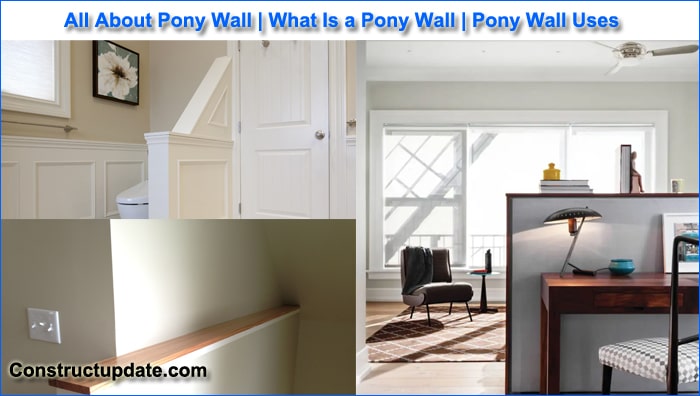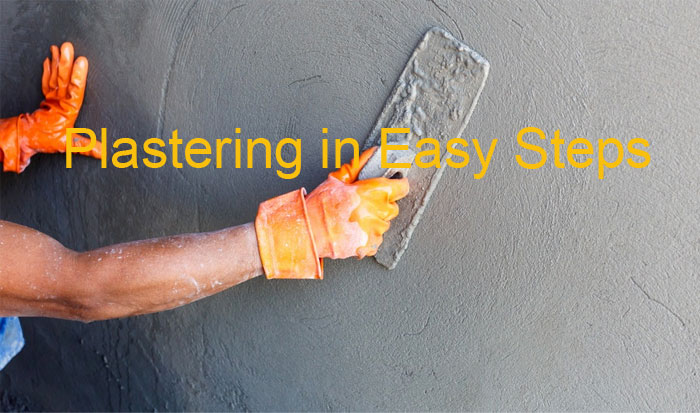What Is a Pony Wall | Pony Walls Types and Uses | Short Partitions Wall Types
Pony walls are short partitions that are mostly used to divide wide-open spaces. The pony wall is a lower-height partition wall also referred to as a half wall.
These walls are around three feet tall. The pony wall successfully separates spaces within rooms and throughout a house.
Wood, gypsum board, steel, and other materials are used in the half-wall construction. However, under all conditions, a pony wall is defined in the same way.
What Is a Pony Wall?
It’s a tiny pony wall. It is also referred to as the “knee wall” because it is a small design wall that does not extend from the ground to the ceiling. With the exception of the rejection of a clean environment, these walls are a great way to reduce the size of a large room.
The parallel material to which the naturally upright item will conjoin is the pony wall’s top facts as well as its lower plates. The walls of the indoor ponies will be painted like drywall.
Each home cabin will use the adaptable construction material known as pony class walls. From the front door to the bathroom to the living room, pony walls can be seen dividing large spaces into smaller ones and preserving pure, fresh air. A wall is also frequently seen as saving siding at the top of the stairway. Naturally, the pony wall design will be used for sophisticated stock locations.

Pony Wall Origin
Since 150 years ago, a farmer in Nebraska has been building a little wall that has come to be known as “pony wall” since it has made it easier to see inside horse barns.
Pony walls, which are coordinated with knee walls and half walls, are known by the term “pony wall,” which is used in the estate to refer to family and private businesses.
Pony Wall from Ceiling
Pony walls, which indicate to provide a division between two chambers while still supplying a clear cover, start at the surface but do not extend all the way to the roof.
Pony Wall Bathroom
Create a pony wall in the bathroom to keep the toilet from being visible from the outside when the door is open. This will obscure the toilet and draw attention to the shower wall and other native building goals.
Uses of Pony Wall
In a home, the pony wall can be used in a number of ways, such as for storage, to divide rooms, or just for aesthetic purposes.
Look at a few instances when pony-style walls have improved both the functionality and overall beauty of a space. The most typical applications for a pony wall include the following.
1. Pony Wall Bookshelf
The pony wall can be used as a bookshelf in two halves, and the simplest option is to convert the upper wall into a shelf by simply cutting an opening in the wall, filling it with books, and adding a bracket to the top of the pony kind wall.
2. Staircase Entryway
It offers a stable foundation for attaching siding and allows for extra wall space to hang pictures. As well as creating the stairway’s finishing wall, different builders will build the wall opposite the entrance.
By providing a suitable backdrop for accessory fixing, this sort of building protects people from falling off the corner.
3. Bathroom Separator
Pony walls are typically used in restrooms, where they can aid in providing privacy in that area. To give the shower a distinctive appearance, these wall chalices at the top of the roof might be installed.
4. Kitchen Breakfast Bar
The dining area will be used as a cooking room the most, with the pony walls continuing all the way to the kitchen. It receives a response to fix the kitchenware as a distinct area of each room.
5. Decorative Wooden Slats
Apply a wall with the parallel wood strap that reaches the pony wall’s upper portion to provide size for the setup of the transparent surface. By aiding the interior structure of the chamber, it increases the cabin’s privacy and adds aesthetic value.
6. Shower and Washroom Divider
If you build one in the bathroom, you can save a goblet over it for more natural beauty. You will feel safer if you keep pony walls close to the toilet. These walls will become well-known in bathrooms for giving a showcase a clean look. These walls will be made of flagstone, thus water resistance is essential.
7. Great Room Separator
The pony wall will apply to distinct zones with many objectives for the living room or dining area. It must be challenging to develop an indoor pattern image for a clear-defined surface idea occasionally.
8. Partition Entryway
By designing a pony wall between the drawing room as an entrance and shoes as outside goods left beyond the wall, the washing room will be made. These walls discourage foot circulation from the front door to the most important area of your property, which they won’t be able to see from the drawing room on this location.
9. Child Space
Due to their diminutive height, pony walls are ideal for providing a separate space for children, and they may be used to divide a variety of rooms to create play areas in other areas.
Pros of Pony Wall
Here, the advantages of the pony wall are as follows.
Pony barriers / short partitions wall can be constructed as delicately as is required. You can choose the ideal candidate for your needs. Pony walls can be styled in almost any way to set the style of any house.
The installation of a pony wall doesn’t require the services of a specialist.
A pony wall would work for both areas. If you have a clear surface concept, you may choose sunshine clearance, but you might not enjoy how the entire cabin must be bright?
Pony walls offer the most help for the climate.
Cons of Pony Wall
Here, the disadvantages of pony wall are as follows.
Pony walls on a surface could be confusing. Pony walls can reduce a home’s size by segmenting it into little spaces.
You might feel that having pony walls over you has its limits. A pony wall could give the impression that a small, confined location, like the bathroom, is less private.
How to Build a Pony Wall
Before assembling your pony wall, plan its space. It is a procedure that complements the path-maker design of the home’s interior huge walls.
The end panel facilitates the well-known pony wall construction method.
If the pony wall is longer than 3–4 feet, additional surface boosting is permitted.
The wood-marble surface will be topped with smaller pony walls.





